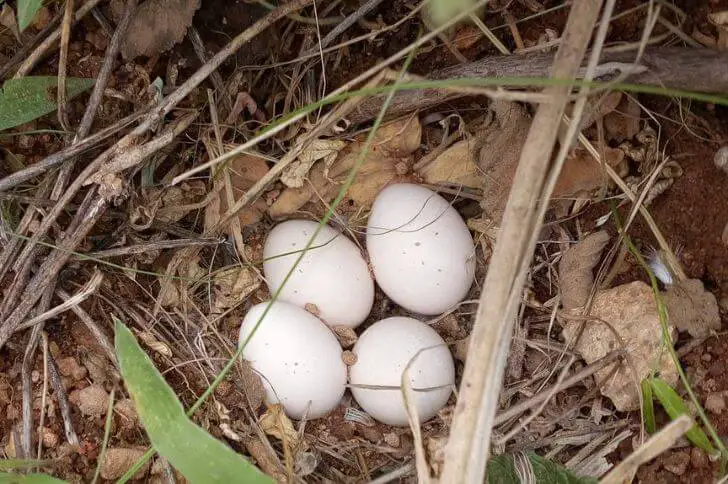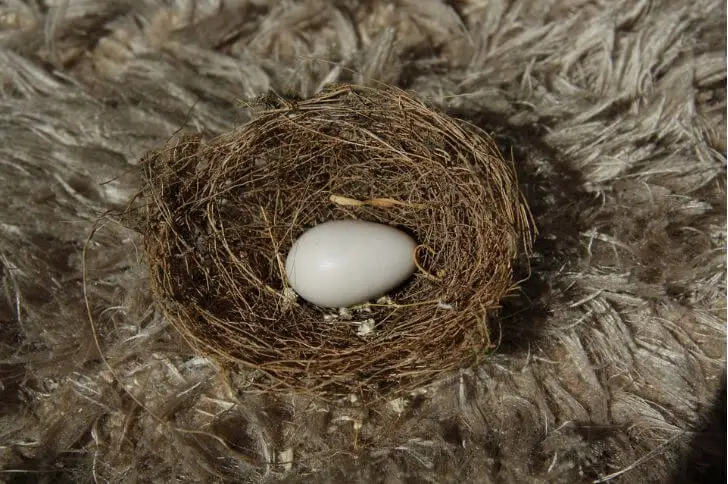Greater roadrunners are one of the fastest and most agile creatures in the animal kingdom. They can run up to 26 miles per hour, and they can jump up to six feet in the air. Despite their quickness, they are not afraid of getting close to predators, and they will often pursue their prey.
If you are wondering about the greater roadrunner and lesser roadrunner nesting habits, this article is for you. We’ll explore how these small birds build nests, their eggs, and first weeks of life.
Roadrunner Eggs, Babies & Nesting Habits
Nest construction

What does a roadrunner’s nest look like? Roadrunners build their nests on the ground, and they can be quite difficult to find. The mating pair move around together looking for the perfect site. Mostly they’ll pick an elevated spot that is well-concealed and shaded.
Male roadrunners will find the coarse materials consisting of twigs, leaves and grasses and bring them to the female. She in turn weaves the cup-shaped nest measuring about 17 inches. Then she will line the nest with softer materials consisting of snakeskin, manure and feathers. These materials help keep eggs warm.
Where do roadrunners nest?
Roadrunners can be found in a variety of habitats, from desert scrub to brushy country. They are ground-dwelling birds and typically nest on the ground. However, there have been reports of roadrunners nesting in trees or other elevated locations.
Where do roadrunners live?
The roadrunner is a bird that is found in the southwestern United States. All year round the greater roadrunner can be found in Arizona, Nevada, South California, New Mexico and Texas.
When do roadrunners lay eggs?

Source: tranquil_soul_6690
Roadrunners typically lay eggs in the springtime, but there is no exact time frame that they follow. The female roadrunner will choose a spot on the ground to lay her eggs and will then incubate them for about two weeks.
How many eggs do roadrunners have?
The courtship is quite interesting. One of the birds, male or female, picks a stick and offers it to their preferred mate and then starts the courtship process or one bird will chase the other until they accept their courtship request.
After building a nest and mating, the female will lay about 2-6 eggs; one egg a day.
How long do roadrunners sit on their eggs?
For about 20 days. The roadrunner egg is a speckled pale yellow. They may have speckles that are darker and are around the large end of the egg where the embryo is located. This bird eggs measures about 1.8 inches in length and about 1.3 inches in diameter. Both roadrunner pairs take turns to sit on the eggs but the duty is mostly left to the male.
How many babies do roadrunners have?
On average, the greater roadrunner and lesser roadrunner mated pair has 3-5 babies, but can sometimes have up to 6. Chicks hatch after day 20 of incubation.
What do baby roadrunners look like?

The greater roadrunner baby has a black skin after hatching. The eyes are closed and note the white downy feathers on the feather tracts. The chicks can walk around. Within a few weeks you’ll notice them taking on the distinctive adult plumage. Juvenile roadrunners are brown or tan with heavy black streaks. Note the blue-red skin behind their eyes.
When lesser baby roadrunners are born, they are covered in white down feathers. As they grow, their feathers become more brown and black. Baby roadrunners have big, though closed eyes and a long tail. They can run very fast, and they can also fly short distances.
Related Read: Learn about chickadee eggs
What are baby roadrunners called?
They are called chicks. Baby roadrunners are brown with white stripes on their head. They grow up to be brown with white streaks down their back.
What do babies eat?
Roadrunners are mostly carnivorous, eating small prey such as lizards, snakes, rodents, and insects. They also eat fruit and seeds. Roadrunner chicks eat mostly insects in their first few weeks of life. As they grow older, you’ll see them chasing lizards and other small animals.
How long do baby roadrunners stay in the nest?
The baby roadrunners stay in the nest for about three weeks. Once they are out of the nest, they learn how to fly and hunt from their parents.
FAQs
How fast is a roadrunner?
On average 26 miles per hour. The adult roadrunner is a fast and agile bird that is found in the deserts of the southwestern United States. Roadrunners can reach speeds of up to 26 miles per hour when running, and they are also great climbers. They use their speed and agility to escape predators and to capture prey.
What kind of a bird is the roadrunner
Roadrunners are slender birds with long tails and broad wings. They have brown-black streaked upperparts, pale underparts, and a distinctive black crown. Notice the red-blue patch behind the eyes. Roadrunners are predators that feed on small mammals, reptiles, and insects. They are known for their speed and agility, which allows them to outrun most predators.
Are there roadrunners in Arizona?
Yes, there are roadrunners in Arizona. Roadrunners are common throughout the state and can be found in a variety of habitats, including deserts, grasslands, and scrublands. These birds are well-adapted to life in the desert and can tolerate high temperatures and periods of drought.
What do roadrunners eat in Arizona?
Roadrunners are omnivorous, which means that they eat both plants and animals. In Arizona, roadrunners typically eat lizards, rattle snakes, snails, spiders, and insects. They may also eat small rodents or eggs. Roadrunners usually catch their prey by running after it but can also catch insects by jumping. They are also known to kill prey by striking it with their beak.
Do roadrunners fly?
Roadrunners are able to fly, but they rarely do so. Instead, these birds prefer to run quickly across the ground. Roadrunners have wings, but they are not very strong and are mainly used for balance while running.
Also read: Learn more about emu eggs and babies
Are roadrunners protected in Arizona?
In Arizona, the roadrunner is protected under state law. The law states that it is illegal to kill, injure, or harass a roadrunner. Roadrunners are not listed as a threatened or endangered species, but they are considered a species of special concern. This means that they may become threatened or endangered in the future if their habitat is destroyed.
How long do roadrunners live?
The average lifespan of a roadrunner is around six to eight years. Their primary predators are hawks and coyotes, so they have developed several strategies for avoiding danger. One is their speed; they can reach speeds of up to twenty six miles per hour. Roadrunners also use vocalizations and alarm calls to warn other birds of impending danger.
Do roadrunners mate for life?
They are known to form long-term bonds. Roadrunners reach maturity at age 3 and find their lifetime partner.
How many times a year do greater roadrunners have nestlings?
Roadrunners have anywhere from one to six babies a year. If there is plenty of food, parents can consider having another brood of three to five babies.
Hi, my name is Steve. My friend and I started the spanishbirdguides.com to share our passion with other like-minded people. So, if bird watching is your thing, you’ll love this blog. I’ll share what I’ve learnt about both local birds and those found in other parts of the world. Also, I’d love to hear your experiences.



